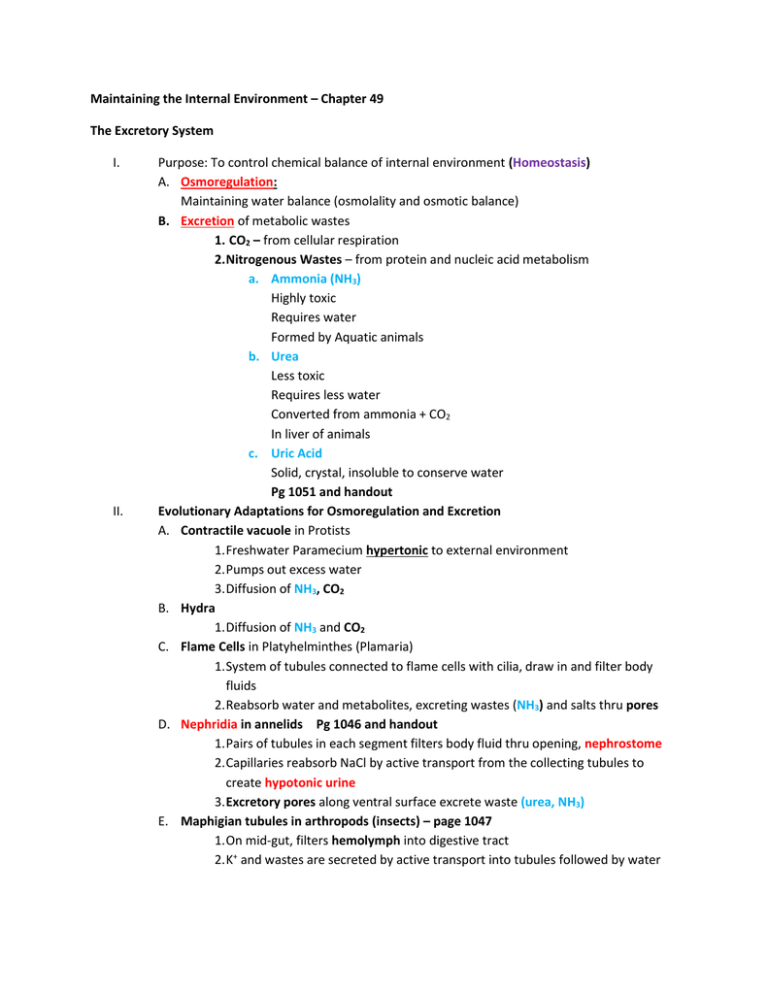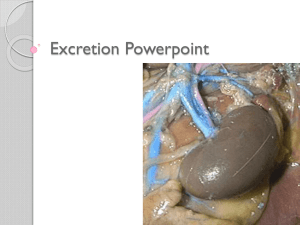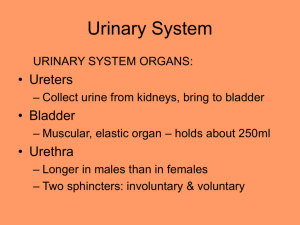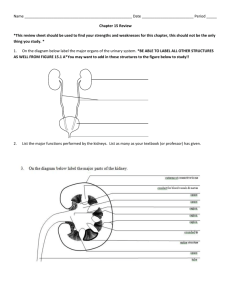Maintaining the Internal Environment – Chapter 49 The Excretory
advertisement

Maintaining the Internal Environment – Chapter 49 The Excretory System I. II. Purpose: To control chemical balance of internal environment (Homeostasis) A. Osmoregulation: Maintaining water balance (osmolality and osmotic balance) B. Excretion of metabolic wastes 1. CO2 – from cellular respiration 2. Nitrogenous Wastes – from protein and nucleic acid metabolism a. Ammonia (NH3) Highly toxic Requires water Formed by Aquatic animals b. Urea Less toxic Requires less water Converted from ammonia + CO2 In liver of animals c. Uric Acid Solid, crystal, insoluble to conserve water Pg 1051 and handout Evolutionary Adaptations for Osmoregulation and Excretion A. Contractile vacuole in Protists 1. Freshwater Paramecium hypertonic to external environment 2. Pumps out excess water 3. Diffusion of NH3, CO2 B. Hydra 1. Diffusion of NH3 and CO2 C. Flame Cells in Platyhelminthes (Plamaria) 1. System of tubules connected to flame cells with cilia, draw in and filter body fluids 2. Reabsorb water and metabolites, excreting wastes (NH3) and salts thru pores D. Nephridia in annelids Pg 1046 and handout 1. Pairs of tubules in each segment filters body fluid thru opening, nephrostome 2. Capillaries reabsorb NaCl by active transport from the collecting tubules to create hypotonic urine 3. Excretory pores along ventral surface excrete waste (urea, NH3) E. Maphigian tubules in arthropods (insects) – page 1047 1. On mid-gut, filters hemolymph into digestive tract 2. K+ and wastes are secreted by active transport into tubules followed by water 3. Water, K+ and nutrients are absorbed into “blood” leaving wastes to pass through and out anus (solid, uric acid, no urine) 4. Conservation of water 5. All the aforementioned animals are Invertebrates The following are all Vertebrate Adaptations III. F. Freshwater Bony Fish – page 1049 1. First appearance of kidney 2. Body fluid is hypertonic to surrounding water 3. Tend to take in water, excrete solutes 4. Adaptations a. Do NOT drink water b. Excrete large volumes of dilute urine (hypotonic to body fluid) c. Absorb salt through gills and kidney tubules G. Marine Bony Fish 1. Probably evolved from freshwater ancestors 2. Hypotonic to surroundings 3. Tend to lose water, take in salts 4. Adaptations a. Drink constantly b. Constantly urinate (isotonic to fluids, contain ions) c. Release ions through gills by active transport H. Mammalian Kidney (human) – page 1052 1. Filters blood to form urine of excess water, salts, wastes 2. Urine is isotonic to interstitial fluid BUT hypertonic to blood (conservation of water). The Nephron – Basic Unit of kidney – page 1053 A. Parts of the Nephron 1. Bowman’s Capsule + Glomerulus (capillaries) – peritubular capillaries surround nephron for absorption 2. Proximal Convoluted tubule a. Nutrients reabsorbed b. Active transport of Na+ c. Water follows d. Filtrate isotonic to blood 3. Descending Loop of Henle a. Permeable to water b. Impermeable to NaCl c. Filtrate hypertonic 4. Ascending Loop of Henle a. Impermeable to water B. C. D. E. b. Permeable to NaCl, urea c. Countercurrent flow d. Creates hypertonic medulla e. “Pulls” water from descending loop and collecting duct f. Filtrate hypertonic 5. Distal convoluted Tubule a. Hypotonic filtrate b. Water reabsorbed c. Regulated by hormones 6. Collecting tubule – urine a. Final reabsorption water b. Flows through hypertonic medulla c. Some urea also diffuses out d. Final urine hypertonic How the Nephron functions to maintain homeostasis – page 1054 1. Filtration a. Movement of most materials by blood pressure from glomerulus into Bowman’s Capsule (filtrate) b. Not blood cells, large blood proteins 2. Secretion a. Movement of foreign molecules, wastes, H+, K+ into filtrate b. Occurs at convoluted tubules 3. Reabsorption a. Movement of materials back into blood by active transport b. Useful materials, ex: glucose, amino acids, water, etc. 4. Excretion a. Elimination of waste products, excess materials in urine b. Collecting tubules c. Urine Osmoregulation in Nephron 1. Changing permeabilities of nephron tubules to water, Na+ 2. Goal: to create hypertonic urine to conserve water 3. Countercurrent multiplier/exchange occurs in Loop of Henle a. Ascending Loop creates a hypertonic area around descending loop of Henle & collecting tube to allow osmosis and reabsorption of water into blood b. Longer the Loop of Henle, more water reabsorbed (birds, humans) Controlling Salt Balance 1. Bicarbonate ions, K+ completely reabsorbed into blood from proximal tubules 2. Distal tubule regulates amounts of H+, K+ to make urine acidic Hormonal Control of Osmoregulatory Function 1. ADH – Anti-diuretic hormone a. Produced in hypothalamus and released from from pituitary b. Increases permeability of collecting tubules to water c. Water conserved in blood d. Decreases urine volume e. Feedback mechanism! 2. Aldosterone/Angiotensin System – see page 1058 a. Aldosterone produced in adrenal gland (cortex) b. Stimulated by angiotensin (blood protein) when blood pressure is LOW c. Aldosterone increases Na+ and water reabsorption by distal tubules a. Increases blood volume/pressure b. Decreases urine d. Feedback Mechanism!





